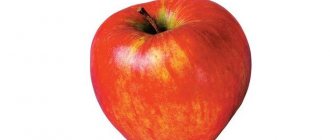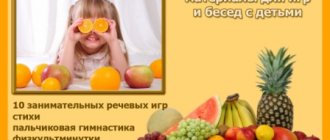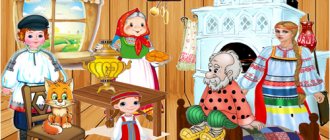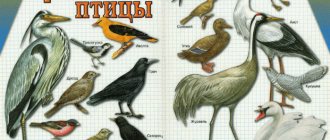Tasks
Examples of tasks that can be used during lessons on the topic “Fruits”:
- Describe the appearance of several fruits using object pictures with their images.
- Compare two similar fruits (apple-peach, pear-quince, tangerine-orange), listing in detail all the common features and differences.
- Name as many characteristics of the fruit shown on the card as possible. One child, children in pairs, or the whole group can list adjectives in a circle.
- Make up a story based on the plot picture, and also come up with several questions for each picture. You can use the following options: “Fruit basket”, “How dried fruits are made”, “From seed to apple”.
- Choose an image of one fruit and come up with as many dishes from it as possible, using the correct name for each (plum marmalade - plum caramel - plum jam).
- Write riddles or short funny poems about fruits on cards.
- Carefully examine one of the pictures, and then, from memory, describe in great detail the fruit that is depicted in it.
- Make up stories in pictures based on several drawings on a topic that are related to each other.
- Using various dried and fresh fruits drawn, come up with a fairy tale about them, compose a short dialogue, and act out (using cards) a short scene.
Fruit basket
Peach
Mandarin
Lemon
Kiwi
Pear
Pomegranate
Banana
Quince
Plum
Cherry
Persimmon
QUINCE
Transcaucasia and Central Asia are considered the homeland of quince; it is in these areas that it is now found in the wild. Quinces have been grown since time immemorial, more than 4,000 years ago. The Latin name for quince is Cytfonia, presumably derived from the city of Cydon on the island of Crete; it was widely cultivated already in the first millennium BC. The ancient Greeks treated the quince with respect; for them it was a symbol of beauty and fertility. It was customary to treat newlyweds to quince. According to one version, the cause of the discord between Hera, Athena and Aphrodite was not an apple, but a quince. Currently, about 400 varieties of quince are known. They differ from each other in the structure of flowers and the shape of fruits. True, the differences between them are not as significant as, for example, between apple varieties.
Quince fruits are yellow in color with different shades, sometimes with a slight blush, very dense, hard and crunchy. If there are greenish spots on the quince, it means that it is not yet fully ripe. The pulp of this fruit is slightly viscous, tart and quite aromatic - the smell has something of an apple, and there is also a coniferous tint. You should only eat ripe quince; it is advisable to give it a chance to age. The longer it sits, the tastier, more aromatic and softer it becomes, the astringent taste disappears. Quince is a very healthy fruit. It contains potassium, magnesium, calcium, vitamin C, malic and citric acids. Quince pulp is rich in pectin. Quince is a universal fruit. It is eaten raw, it makes delicious compotes, jams, preserves, candied fruits, it can be added to porridge, salad, vegetable soup. Quince mustard is a seasoning made from quince and mustard with the addition of ginger and coriander. Quince cheese is condensed quince juice with pulp. Quince is grown in many countries of the world - in Europe, North America, North Africa, East and Central Asia. Cold-resistant varieties have also been developed and are successfully cultivated in the Volga region. Another variety of quince is Japanese quince, or chaenomeles. The flowers and fruits of this plant are similar to quince. Chaenomeles was brought to Europe from Japan at the end of the 17th century. Gradually it gained popularity among gardeners - it has very beautiful decorative flowers. Japanese quince fruits are also edible, but they are more sour.
- To the begining
- Back
- 1
- Forward
- In the end
Fun physical education minutes:
Harvest.
Show actions: carry a ladder, set up a ladder, pick pears, put them in boxes, load them into the car.
2. How a gardener grew an apple tree.
Show actions: the gardener digs a hole, plants an apple tree, whitewashes the trunk of the apple tree, waters, fertilizes, prunes, and collects fruits.
3. Apple.
That's an apple! It's full of sweet juice! (stand up, arms to the sides, stretch) Stretch your hands, pick an apple! (hands up, stretch up) The wind began to shake the twig, it’s hard to pick an apple! (arms up, bend to the sides) I’ll jump up, stretch out my hand and quickly pick an apple! (jumping up, clapping overhead)
PEAR
Pear is very tasty. We are very sad without a pear. Pear is delicious, especially in jam. (I. Goryunova) In terms of popularity and space occupied, the pear is in third place after the apple and cherry trees. Pear cultivation began a long time ago. The ancient Roman writer Cato the Elder, in his treatise “On Agriculture,” written more than two thousand years ago, gave recommendations on how to properly grow pears. Pliny the Elder described 35 varieties of pears in his work. Unlike modern varieties, pears in ancient Rome were hard. They became soft at the end of the 18th century thanks to the efforts of French and Belgian breeders. One of them, Van Monet, developed 400 varieties of pears, 40 of which are still popular today.
Now the number of pear varieties has exceeded several thousand. Pears are grown in gardens; they also grow on forest edges and in clearings in deciduous forests. It feels good on rocky mountain slopes, as it is not picky about the soil and tolerates drought and light frosts. Pear trees begin to bear fruit in 5–7 years. True, at first the harvest is small. But when the tree gains strength, they get up to 200 centners per hectare. Pears live quite a long time, up to 300 years. The oldest fruit tree in the world is considered to be a pear tree, planted in 1630 within the American city of Denver. A wonderful pear, very sweet, like honey. It just begs to be placed in your palm, and then quickly into your mouth. (N. Migunova) The pear fruit consists of 97% pulp, 2.5% is the skin and only 0.5% is the seeds. It contains vitamins D and C, potassium, magnesium, and iron salts. Pears are eaten fresh, many delicious dishes are prepared from them, jams, jams, compotes are made, pears are dried and pickled. RIDDLE Birds hang upside down on the trees between the leaves. (Pears)
Orange.
We bend our fingers one by one.
We shared an orange. There are many of us, but he is alone! This slice is for hedgehogs, This slice is for urchins, This slice is for ducklings, This slice is for kittens. This slice is for the beaver, And for the wolf it is the peel!
Compote.
We depict actions in accordance with the text:
We will cook compote, We need a lot of fruits: We will chop apples, We will chop pears. Squeeze out the lemon juice, drain, and add sand. We cook, we cook compote. Let's treat honest people.
Fruits.
We bend our fingers one by one.
This finger is an orange, He is, of course, not alone. This finger is a plum, delicious, beautiful. This finger is an apricot, growing high on a branch. This finger is a pear, Asks: “Come on, eat it!” This finger is a pineapple, a fruit for you and for us.







